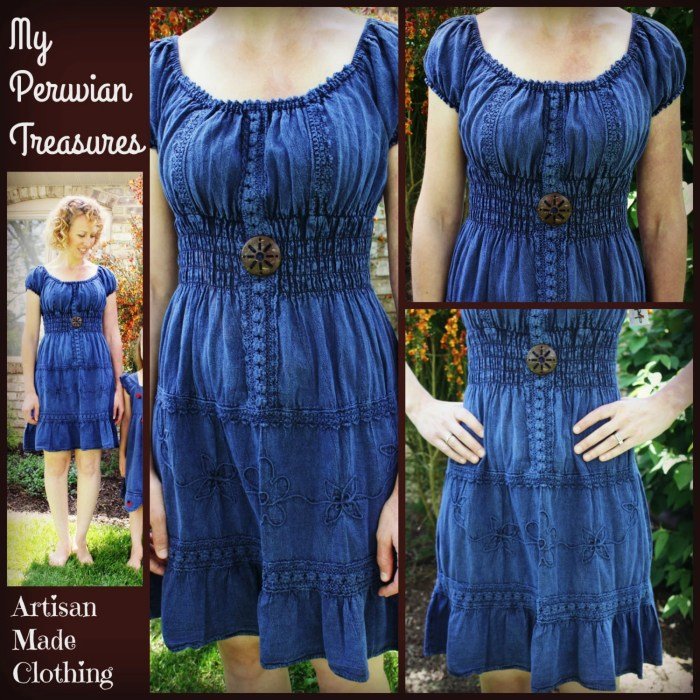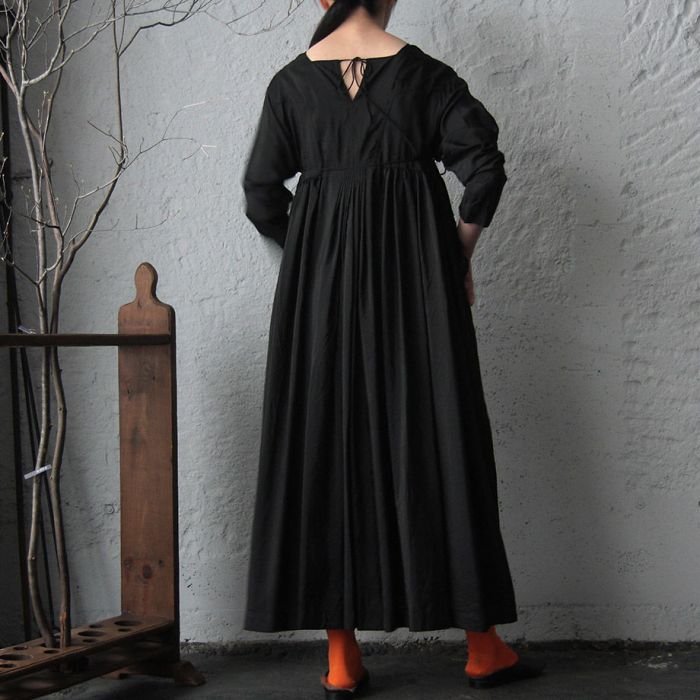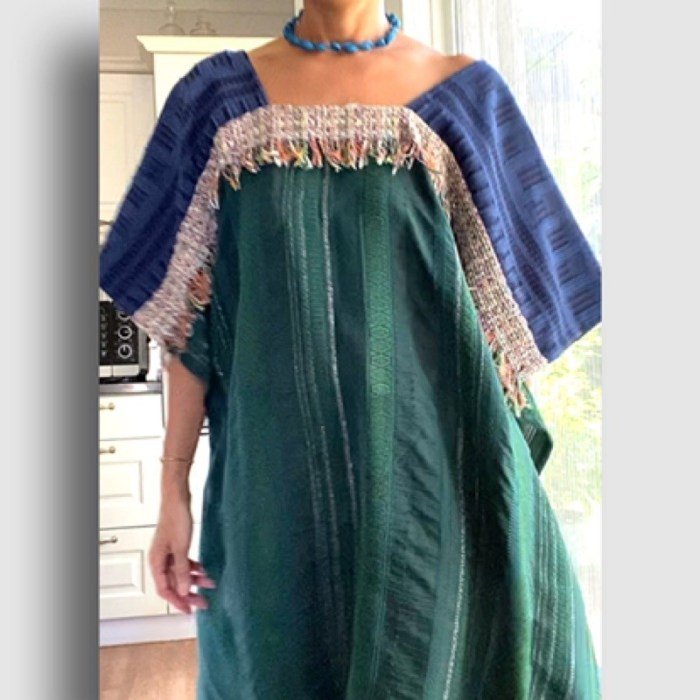Artesanal dresses – In the realm of fashion, artisanal dresses stand as exquisite creations, meticulously crafted with a unique blend of tradition and innovation. These garments are not merely pieces of clothing; they are wearable works of art that embody the rich cultural heritage and skilled craftsmanship of their makers.
From the vibrant hues and intricate embroidery of traditional designs to the sleek lines and modern embellishments of contemporary interpretations, artisanal dresses captivate with their timeless elegance and artistic flair.
Definition and Characteristics of Artesanal Dresses

Artesanal dresses are unique garments that embody the artistry and craftsmanship of traditional and contemporary dressmaking techniques. These dresses are characterized by their intricate details, vibrant colors, and the use of high-quality materials.
Traditional artisanal dresses often draw inspiration from cultural heritage, showcasing the motifs, patterns, and embellishments specific to a particular region or community. Contemporary artisanal dresses, while embracing modern design elements, still maintain the essence of traditional craftsmanship, combining innovative techniques with timeless aesthetics.
Materials, Techniques, and Craftsmanship
Artesanal dresses are crafted using a variety of materials, including natural fibers like cotton, silk, and wool, as well as synthetic fabrics like rayon and nylon. The choice of material depends on the desired look, feel, and drape of the dress.
The techniques used in artisanal dressmaking are as diverse as the materials themselves. Hand embroidery, beading, lacework, and appliqué are just a few examples of the intricate embellishments that adorn these garments. Each technique requires specialized skills and patience, resulting in dresses that are truly works of art.
If you’re seeking an exquisite artisanal dress, consider the enchanting effie heart dresses. These ethereal creations embody the artistry of traditional craftsmanship, featuring intricate details and flowing silhouettes that evoke a timeless elegance. The effie heart dresses effortlessly transition back to the realm of artisanal masterpieces, showcasing the exceptional skill and creativity that defines this timeless fashion genre.
The craftsmanship involved in artisanal dressmaking is evident in the attention to detail and the precision with which each garment is constructed. From the delicate stitching to the intricate beadwork, every element of an artisanal dress is a testament to the skill and dedication of the artisan.
Historical and Cultural Significance of Artesanal Dresses

The history of artisanal dresses is intertwined with the cultural heritage of countless societies worldwide. These garments have played a pivotal role in traditional ceremonies, festivals, and cultural events, serving as vibrant expressions of identity and community.
Regions and Cultures with Distinctive Artisanal Dress Styles
Various regions and cultures have developed unique artisanal dress styles that reflect their traditions, beliefs, and artistic sensibilities. Some notable examples include:
- Mexico:Traditional Mexican dresses, such as the huipil and rebozo, are known for their vibrant colors, intricate embroidery, and cultural symbolism.
- India:Indian artisanal dresses, like the sari and salwar kameez, showcase the country’s rich textile heritage and cultural diversity.
- Japan:Japanese artisanal dresses, including the kimono and yukata, are renowned for their elegance, sophistication, and attention to detail.
These artisanal dresses not only adorn individuals but also serve as cultural artifacts that connect people to their past, present, and future.
Contemporary Trends in Artesanal Dresses
In the contemporary fashion landscape, artisanal dresses continue to captivate with their unique charm and intricate craftsmanship. Modern designers and brands are embracing artisanal techniques, reinterpreting traditional designs, and pushing the boundaries of innovation in dressmaking.
One notable trend is the fusion of artisanal elements with modern silhouettes and fabrics. Designers are experimenting with incorporating traditional embroidery, beadwork, and weaving into contemporary dress designs, creating a harmonious blend of the old and new. This fusion allows for the preservation of cultural heritage while embracing modern aesthetics.
Influence of Modern Fashion Trends
Modern fashion trends have significantly influenced artisanal dressmaking. The rise of sustainability and ethical fashion has led to an increased demand for handmade and eco-friendly garments. Artisanal dresses, with their emphasis on craftsmanship and often locally sourced materials, align well with this trend.
Moreover, the popularity of athleisure and streetwear has influenced the incorporation of comfort and functionality into artisanal dresses. Designers are creating artisanal dresses that are not only visually stunning but also comfortable to wear, blurring the lines between fashion and everyday wear.
Influence of Cultural Movements
Cultural movements, such as the global resurgence of indigenous cultures and the empowerment of marginalized communities, have also played a role in shaping contemporary artisanal dress trends. Designers are drawing inspiration from traditional crafts and techniques of diverse cultures, celebrating their heritage and fostering cultural exchange.
For example, the revival of traditional Mexican embroidery techniques has led to the creation of stunning artisanal dresses that showcase the vibrant colors and intricate designs of this cultural heritage.
Contemporary Designers and Brands
Numerous contemporary designers and brands are showcasing artisanal dress collections, each with their unique interpretation and approach. Here are a few notable examples:
- Gabriela Hearst: Known for her sustainable and ethical approach, Hearst incorporates artisanal techniques from around the world into her sophisticated dress designs.
- Chloé: Under the creative direction of Natacha Ramsay-Levi, Chloé has embraced artisanal craftsmanship, showcasing dresses with intricate embroidery and bohemian flair.
- Zimmermann: The Australian brand is renowned for its feminine and ethereal dresses, often featuring delicate lacework and intricate beading, inspired by global travels.
Artisanal Dresses for Different Occasions
Artisanal dresses are not only beautiful but also versatile, making them suitable for a wide range of occasions. Whether it’s a formal event, a casual gathering, or everyday wear, there is an artisanal dress to suit every need.
Formal Events, Artesanal dresses
For formal events such as weddings, galas, and award ceremonies, artisanal dresses made from luxurious fabrics like silk, lace, and velvet are a popular choice. These dresses often feature intricate embroidery, beadwork, or other embellishments that add a touch of elegance and sophistication.
- A floor-length silk dress with a lace bodice and beaded embellishments.
- A velvet dress with a fitted bodice and a flowing skirt adorned with intricate embroidery.
- A lace dress with a high neckline and long sleeves, perfect for a winter formal event.
Casual Gatherings
For more casual gatherings, such as brunches, parties, and picnics, artisanal dresses made from lighter fabrics like cotton, linen, and chiffon are more appropriate. These dresses are often more comfortable and easy to wear, and they can be dressed up or down with accessories.
- A cotton dress with a floral print and a ruffled hem.
- A linen dress with a simple silhouette and a few delicate embroidery details.
- A chiffon dress with a flowy skirt and a lace bodice.
Everyday Wear
Artisanal dresses can also be worn for everyday wear, such as running errands, going to the office, or meeting friends for coffee. These dresses are often made from more durable fabrics like denim, chambray, or canvas, and they are designed to be comfortable and stylish.
Artesanal dresses, with their intricate details and vibrant colors, have become increasingly popular. Among the many variations, geeta dresses stand out with their unique designs and exceptional craftsmanship. These dresses embody the spirit of artisanal fashion, blending traditional techniques with modern sensibilities to create wearable works of art that reflect the rich cultural heritage of their makers.
They are a testament to the skill and creativity of artisans worldwide, showcasing the beauty and diversity of handcrafted garments.
- A denim dress with a button-down front and a flared skirt.
- A chambray dress with a shirred bodice and a ruffled hem.
- A canvas dress with a simple silhouette and a few pockets for added functionality.
Sustainability and Ethical Considerations in Artesanal Dressmaking
Artesanal dressmaking embraces sustainable practices and ethical considerations, promoting eco-friendliness and fair labor practices throughout the production process. By using sustainable materials and ensuring fair compensation for artisans, this approach fosters environmental and social responsibility in the fashion industry.
Materials and Environmental Impact
Artesanal dressmakers prioritize eco-friendly materials, such as organic cotton, hemp, and recycled fabrics, which reduce the environmental footprint of production. These materials minimize water and energy consumption, pesticide use, and carbon emissions compared to conventional textiles. Additionally, natural dyes derived from plants and minerals offer sustainable alternatives to synthetic dyes, reducing chemical pollution.
Fair Labor Practices
Ethical considerations extend to fair labor practices, ensuring that artisans are treated with respect and compensated fairly for their skills. This includes providing safe and healthy working conditions, reasonable working hours, and access to healthcare and other benefits. Supporting artisans through fair wages and working conditions promotes their livelihoods and preserves traditional craftsmanship techniques.
Initiatives and Organizations
Numerous initiatives and organizations advocate for sustainability and ethical practices in artisanal dressmaking. The Global Organic Textile Standard (GOTS) certifies organic fibers and textiles, ensuring they meet environmental and social criteria. Fair Trade organizations, such as the World Fair Trade Organization (WFTO), promote fair wages and working conditions for artisans worldwide.
These initiatives help consumers make informed choices and support sustainable and ethical fashion practices.
Global Influence of Artesanal Dresses
In the contemporary fashion landscape, artisanal dresses have garnered widespread appreciation and influence on a global scale. This recognition stems from the unique charm, intricate craftsmanship, and cultural heritage embedded in these garments.
Fashion magazines, social media platforms, and international events have played a pivotal role in showcasing artisanal dressmaking to a broader audience. Renowned fashion publications like Vogue and Harper’s Bazaar regularly feature articles and editorials highlighting the beauty and artistry of artisanal dresses, while social media platforms such as Instagram and Pinterest provide a virtual stage for designers to connect with a global clientele.
International Recognition of Artisanal Dress Designers
Several artisanal dress designers have gained international recognition for their exceptional creations, contributing to the global influence of artisanal dresses. Notable examples include:
- Carolina Herrera: Known for her elegant and timeless designs, Carolina Herrera has incorporated artisanal techniques and traditional motifs into her collections, showcasing the beauty of Latin American craftsmanship.
- Oscar de la Renta: This Dominican-American designer was renowned for his vibrant and feminine designs, often featuring intricate embroidery and beadwork inspired by his Caribbean heritage.
- Zuhair Murad: A Lebanese designer, Zuhair Murad’s creations are characterized by their opulent embellishments, luxurious fabrics, and intricate beading, drawing inspiration from his Middle Eastern roots.
Comparison of Artesanal Dresses with Mass-Produced Dresses
Artesanal dresses, meticulously crafted by skilled artisans, stand in stark contrast to mass-produced dresses, churned out in factories using automated processes. This stark difference is reflected in their characteristics, quality, and value.
Artesanal dresses exude a timeless charm, capturing the essence of craftsmanship and cultural heritage. Martha’s Vineyard dresses, martha’s vineyard dresses , embody this spirit with their intricate details, vibrant colors, and effortless elegance. These artisanal creations seamlessly blend tradition and modernity, showcasing the enduring beauty of handmade garments.
Design and Materials
Artesanal dresses are characterized by unique designs, often inspired by cultural heritage or personal experiences. They are made from high-quality, sustainable materials such as organic cotton, silk, and linen, ensuring durability and comfort. In contrast, mass-produced dresses often follow fast fashion trends, prioritizing affordability over originality.
Artesanal dresses are handcrafted garments that often showcase traditional techniques and intricate designs. If you’re looking for a unique and culturally rich addition to your wardrobe, consider exploring sri lanka dresses. These dresses often feature vibrant colors, delicate embroidery, and flowing silhouettes, reflecting the beauty and artistry of Sri Lankan culture.
From casual everyday wear to elegant evening attire, artesanal dresses offer a versatile and timeless style.
They are typically made from synthetic fabrics, which may be less breathable and environmentally friendly.
Craftsmanship and Quality
Artesanal dresses are painstakingly crafted by hand, with attention to detail evident in every stitch and embellishment. Artisans employ traditional techniques passed down through generations, resulting in exceptional craftsmanship and durability. Mass-produced dresses, on the other hand, are made quickly and efficiently, often sacrificing quality for speed and cost-effectiveness.
Price and Availability
The labor-intensive nature of artisanal dressmaking contributes to their higher price point compared to mass-produced dresses. Additionally, the limited production quantities and exclusive nature of artisanal dresses further drive up their value. Mass-produced dresses, on the other hand, are widely available at lower prices due to their mass production and economies of scale.
Styling and Accessorizing Artesanal Dresses
Styling artisanal dresses requires a delicate balance between preserving their unique charm and enhancing their aesthetic appeal. Here are some tips to help you elevate your artisanal dress style:
Footwear
- Consider the occasion and dress design when choosing footwear. For formal events, heels or wedges complement the elegance of artisanal dresses.
- For casual outings, flats or sandals provide a comfortable and stylish option.
- If the dress has intricate embroidery or beading, opt for simpler footwear to avoid overpowering the design.
Jewelry
- Delicate jewelry, such as earrings or a necklace, can accentuate the intricate details of artisanal dresses.
- Choose pieces that complement the dress’s color scheme and style.
- Avoid overwhelming the dress with excessive jewelry.
Accessories
- Scarves, shawls, or belts can add a touch of sophistication to artisanal dresses.
- Consider the texture and pattern of the dress when selecting accessories.
- Accessorize with items that enhance the overall aesthetic of the dress without detracting from its unique charm.
Final Review

As the appreciation for artisanal dresses continues to grow, these garments have become a symbol of cultural pride, sustainability, and the enduring power of human creativity. Whether adorning the pages of fashion magazines or gracing the bodies of discerning individuals, artisanal dresses continue to inspire and enchant, leaving an indelible mark on the world of style.
Query Resolution
What makes an artisanal dress unique?
Artisanal dresses are distinguished by their handmade construction, intricate detailing, and the use of traditional techniques and materials.
Are artisanal dresses only suitable for formal occasions?
No, artisanal dresses can be designed for a variety of occasions, from formal events to casual gatherings and everyday wear.
How can I style an artisanal dress?
Artisanal dresses can be styled with a variety of accessories, such as statement jewelry, scarves, and belts, to create different looks.